Before committing to a new skid steer attachment for snow removal, there is a lot to consider, especially if you want to get the most bang for your buck. The truth of the matter is, there are a lot of great snow mover attachments available on the market today. But finding the best attachment has to start with you and what you need.
In the next few chapters, we will dive into the different types of skid steer snow movers, covering their unique specifications and the pros and cons of that category. But before we do that, let’s discuss the key things to consider before making a purchase.
How to Choose A Skid Steer Snow Removal Attachment
4 Key Considerations
1. Intended Application or Function
One attachment is not better than another in every application. Instead, the right attachment for you is dependent on your snow removal needs. Understanding the uses and benefits of each attachment is crucial to purchasing the right equipment for the job.
Some snow removal jobs require multiple attachments to be completed effectively. Obstacles like uneven terrain, confined spaces, barriers, and highly-traveled areas should be kept in mind when making a decision. A versatile inventory or more versatile attachments can help you to overcome these obstacles.
2. Skid Steer or Tractor Size
Small- and medium-frame skid steers may have a tough time pushing snow long distances. Keep this in mind when purchasing buckets, pushers, and blades. Choosing an attachment that is too wide for the machine will add weight, volume, and surface area, all factors capable of affecting performance.
3. Pricing and Budget
If you are looking for a dependable attachment for your operation, price should not be your only deciding factor. When one attachment is cheaper than another, there’s usually a reason for the difference. Instead of only focusing on price, ask more questions before making a final decision. You’ve probably heard it a hundred times, but it still holds true: “you get what you pay for.”
4. Snow Mover Quality
The attachment you purchase needs to have the required structural strength and quality components to withstand the stress that comes with your line of work. Downtime is the greatest issue and expense when the snow is falling. Paying more up-front for a quality attachment is always worth it in the long run.
Types of Snow Removal Attachments
Now that you know what to consider, let’s take a look at your options for skid steer snow movers.
The next six chapters each cover one type of snow mover attachment for skid steers. They are:
- Snow/Light Material Buckets
- Snow Blowers
- Snow Pushers
- Angle Snow Blades
- V-Snow Blades
- Hydraulic Snow Blade Pushers
Let’s get started.
Snow/Light Material Bucket Skid Steer Attachments
Snow/light material buckets are simple and inexpensive attachments designed to move high volumes of light snow and material.
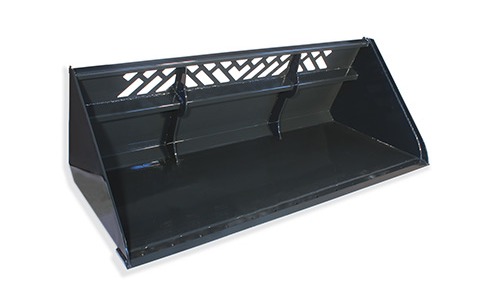
Pros
- Inexpensive—About half the price of a snow blade or pusher.
- Simplicity—No chance of hydraulic or electrical failure. Maintenance-free.
- Multi-Purpose—Can also move light, granular materials such as mulch, grain, wood shavings, and fertilizer.
- Placement—Able to place snow where needed.
- Back Drag—Ability to pull snow away from buildings or objects.
- Visibility—Buckets with pre-cut windows increase visibility.
Cons
- Potential Risk—No trip edge or mechanism to “give way” to manhole covers or other obstacles, increasing the potential to damage property, equipment, and personnel. Small objects may cause the machine to slow down and could make snow removal much more disruptive.
- Constant Dumping—Needing to constantly dump the snow when full and wet snow doesn’t always fall out on its own.
- Overloading—There’s potential for overloading issues to occur.
- Snow Trails—Leaves a trail of snow on both sides. More windrows mean more passes.
- Your budget is limited and you’re looking for an inexpensive attachment.
- You want the simplicity of no moving parts and few replacement parts.
Matching Your bucket to Your Skid Loader
What Width Should I Purchase?
The attachment width should be wider than the tires or tracks of the machine. The attachment should also have a recommended loader capacity rating that matches, or is lower than, the loader operating capacity.
To prevent potential overloading issues, compare the loader’s lifting capacity and tipping weight to the weight of the attachment plus the estimated weight of a load. Different materials will change the estimated weight of a load.
Snow Blower Skid Steer Attachments
Snow blower attachments for skid steers are designed to throw snow and clear paths through some of the deepest drifts. The rotating chute and deflector put snow exactly where you want it.
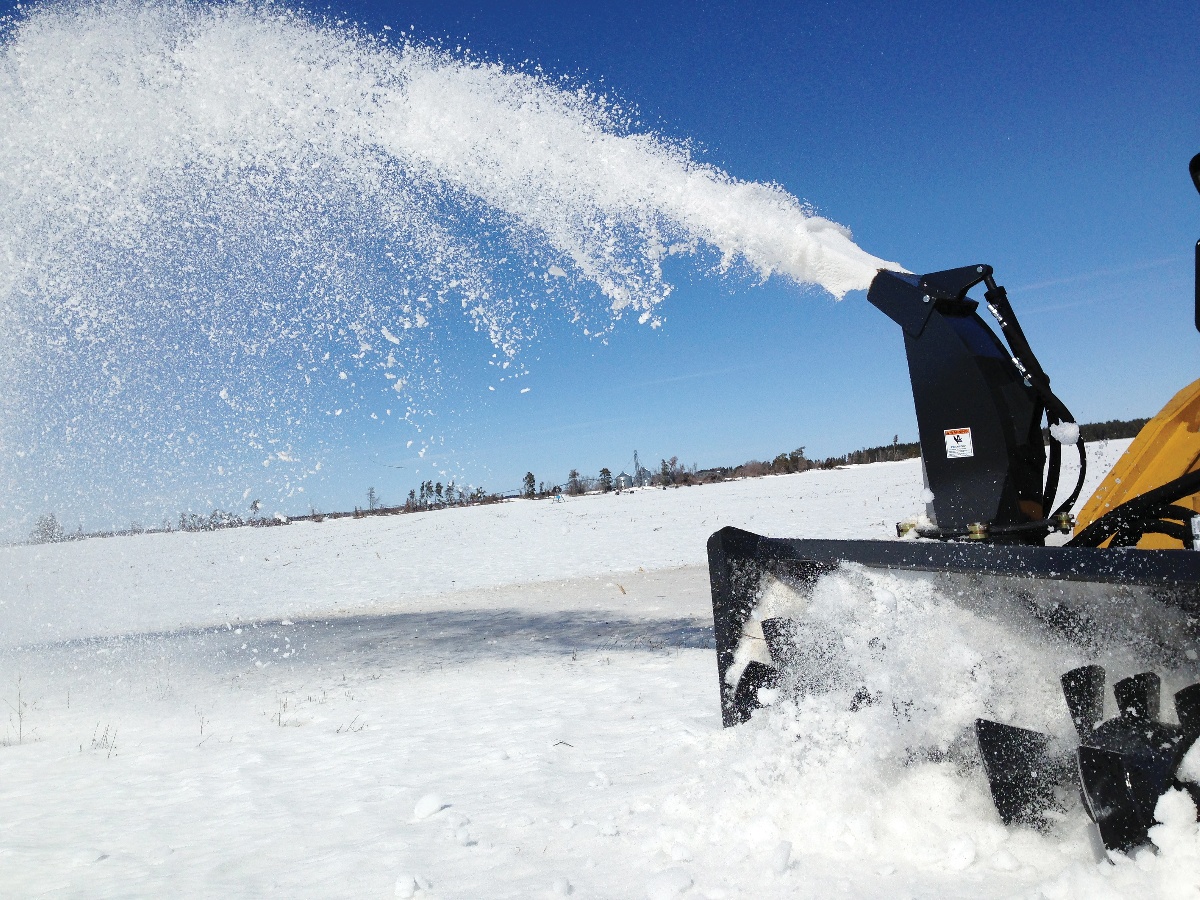
Pros
- No Boundaries—It can go where no blade or pusher can go. Need to tackle that 4’ snow drift? No problem.
- Inexpensive Maintenance—Less money into wear parts than a pusher or plow.
- Placement—The hydraulic chute rotates, and the deflector allows precise snow placement.
- No Traction Issues—Blowers do not cause traction issues in deep snow, like pushers and plows can. You can add a blower on a small-frame skid steer and move snow that’s 2’ deep, you wouldn’t be able to with a plow.
- No Windrows—It will continually move snow without spillage or leaving windrows.
- No Snow Restrictions—Can chew through any type of snow.
- No Surface Restrictions—There are no restrictions on what type of surface it will be best suited. Blowers with poly skid shoes work well on most surfaces, including gravel.
Cons
- Expensive—More up-front cost than Snow Buckets, Angle Snow Blades, and V-Snow Blade attachments.
- Complexity—Has motors and more moving parts than snow pushers and buckets. The deflector requires electric control, and there’s the possibility of hydraulic or electrical failure.
- Slow—Much slower than a blade or pusher.
- Low Performance Possible—Throw distance is heavily dependent on hydraulic performance. A loader with a 15 GPM rating may not perform as well, especially in wet, heavy snow. Generally, the higher the flow and hydraulic pressure, the better.
- Not Versatile to Equip—Requires matching flow rates and electrical resulting in more setup time. Blades and pushers are a simpler setup.
Choose a Snow Blower When:
- You want to be able to clear snow just about anywhere.
- You get a lot of heavy storms with all types of snow.
- Space is limited for piling snow.
- You have areas where it’s impossible to windrow the snow to the sides.
Matching a Snow Blower to Your Skid Steer
What Width Should I Purchase?
For efficient operation, purchase a blower with a cut width that is wider than the tires or tracks of your machine. Machine capacity and flow rate should also be considered. The attachment should have a recommended loader capacity rating that matches or is lower than the loader operating capacity.
Machine Flow Rate
You must know the flow rate of your machine and the minimum and maximum flow rate of the snow blower motor. The flow rate is typically listed in gallons per minute (GPM). The machine’s flow rate should be as close to the max range of the snow blower motor as possible.
For example, let’s say your skid steer has a maximum flow rate of 25 GPM and there are two blower motor options available. One motor is 18-25 GPM and the other is 25-33 GPM. Which one should you choose? You should choose the 18-25 GPM since that is as close to the max range as possible.
Snow Pusher Skid Steer Attachments
Snow pusher attachments are designed to push snow straight ahead without leaving windrows. During operation, the snow is trapped into a box-like attachment and transported.
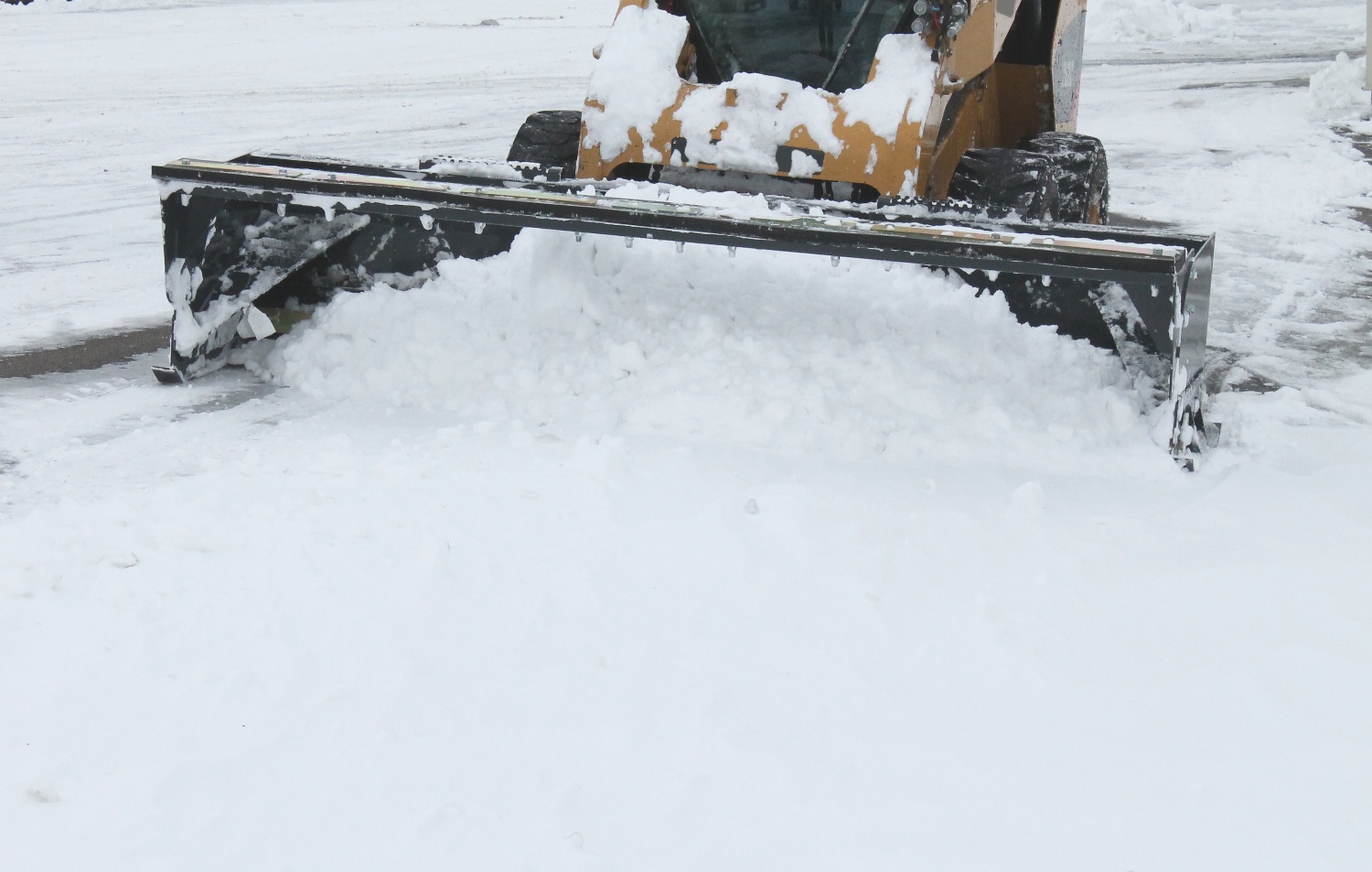
Pros
- Simplicity—Very few moving parts and replacement parts. No chance of hydraulic or electrical failure.
- Speed—Can travel as fast as the machine does, making snow removal quick and effective.
- Side-to-Side Oscillation—Allows the cutting edge to follow the contour of the surface. Results in a cleaner plowed area and the ability to work over uneven terrain.
- Edge Adjusts Automatically—Edge never needs manual adjusting, it only needs to be reversed or replaced.
- Minimal Interruptions—Rigid moldboard and trip edge help minimize plowing interruptions.
- Back Drag—Ability to pull snow away from buildings or objects with a pull back option.
- Scrapes Hard-Pack—Effectively scrapes hard-pack and icy snow (only applies to pushers with steel edge).
- Light Material Handling—Can be used for moving/handling light materials—which includes water, mud, sludge, silage, grain, manure, and trash (only applies to pushers with a rubber edge).
Cons
- Traction—Likely to lose traction on a smaller machine or when plowing deep/ heavy snow.
- Clearing Limitations—Without a pull back you can’t effectively pull snow away from buildings.
- Cannot Angle—Because it can’t angle, you generally have to push snow in one direction, toward the pile. If there is only one pile it means you waste a lot of time going in reverse.
- Windrows—For longer pushes, it often overfills and loses containment, which forces you to go back and clean up windrows.
- Expensive Edges—Rubber edges are expensive to replace (only applies to pushers with rubber edge).
Choose a Snow Pusher Attachment When:
- You have areas where it’s impossible to windrow the snow to the sides.
- You need maximum containment to move snow from between buildings.
- You have a lot of short and straight pushes.
- You want the simplicity of few moving parts.
Matching a pusher to your skid steer
What Width Should I Purchase?
A wider pusher will be more difficult to maneuver in tight spaces. A 96” pusher will push longer and turn a lot easier than a 120” pusher. An 84” pusher may not clear snow quite as fast as a 120”, but it will be more effective in tight areas.
A small-to-mid-sized skid steer will effectively handle an 84” or 96” pusher. A large-framed skid steer will effectively handle a 108” and 120” pusher. Selecting a pusher that is too wide will add weight, volume, and surface area, all factors that could affect performance.
In heavier snow, a loader is more likely to break traction and quit pushing. If pushing long runs or wet and heavy snow, then an 84” or 96” will likely be the better choice—regardless of machine size.
Also, consider the loader’s operating capacity. The pusher should also have a recommended loader capacity rating that matches or is lower than the loader operating capacity. Always refer to the attachment’s spec table to see which model works for a machine.
Angle Snow Blade Skid Steer Attachments
Angle snow blades are one of the most popular attachment options for snow removal. Straight and angle positions allow operators to quickly remove and windrow snow. Adding pin-on wings allows for greater efficiency/functionality.
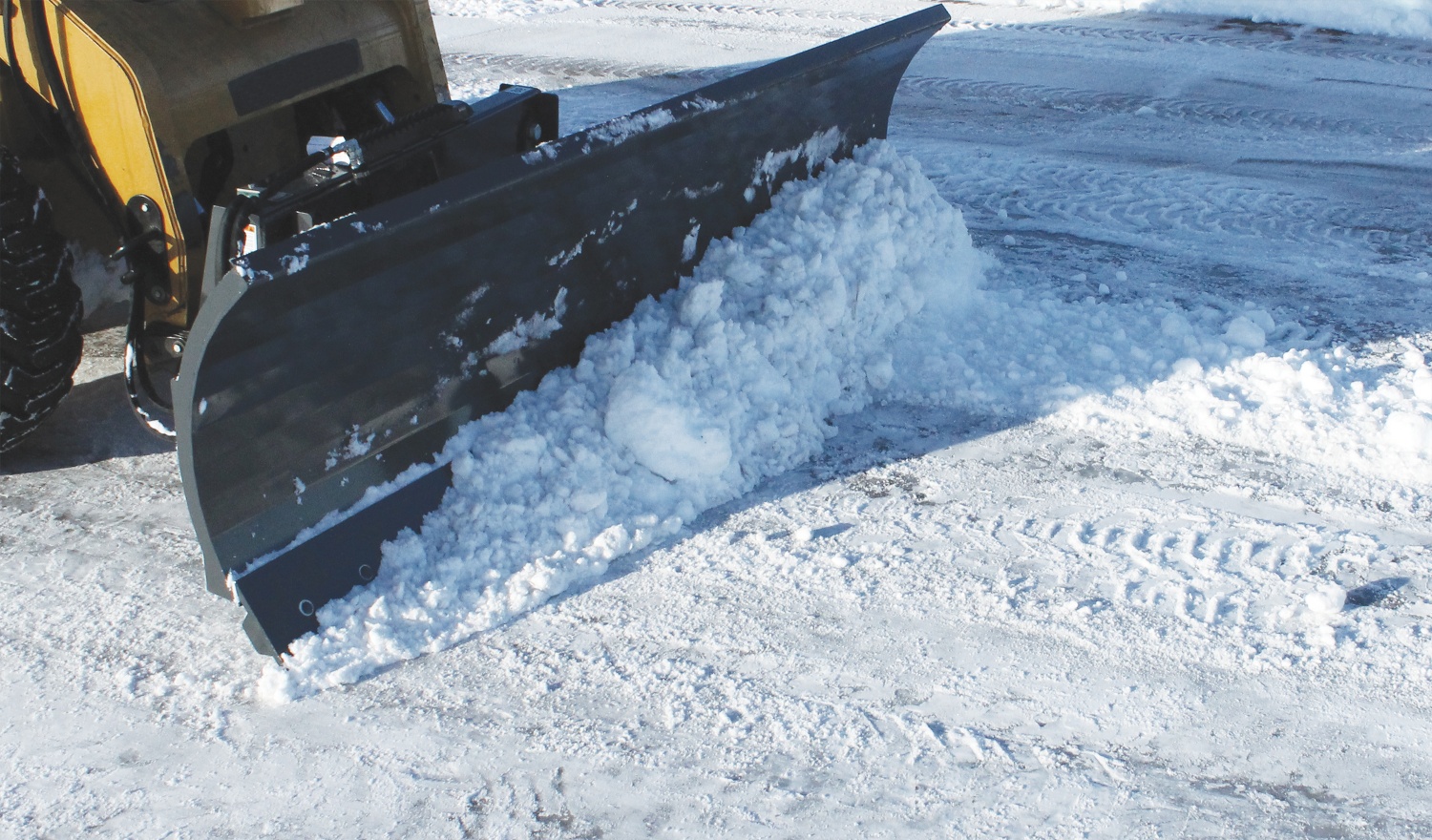
Pros
- Speed—Can travel as fast as the machine does, which allows for quick and effective snow removal.
- Stacking Ability—Since the blade sticks out further than a pusher or bucket, it allows snow to be stacked better and higher. It’s a night and day difference.
- Minimal Interruptions—Rigid moldboard and trip edge help minimize plowing interruptions.
- Side-to-Side Oscillation—Allows the cutting edge to follow the contour of the surface. Results in a cleaner plowed area and the ability to work over uneven terrain.
- No Electric—Blade angles hydraulically.
Cons
- Traction—Can lose traction in deep snow. Always refer to the attachment’s spec table to see which model works for a machine.
- Containment—Unless wings are added, they don’t contain much snow.
- Complexity—More moving parts than snow pushers and buckets. Chance of hydraulic failure.
- Ground Sensitive—Most effective on hard surfaces like pavement or concrete.
- Won’t work well on gravel unless the ground is frozen or hardpack is present.
Choose an Angle Snow Blade Attachment When:
- You are clearing fairly large areas like parking lots or driveways.
- Containment is less important.
Matching an Angle Snow Blade to Your Skid Loader
What Width Should I Purchase?
At minimum, the blade width at full angle should be wider than your machine’s tracks or tires. The attachment should have a recommended loader operating capacity rating that matches or is lower than the loader lift capacity. Always refer to the attachment’s spec table to see which model works for a machine.
A small-to-mid-sized skid steer will effectively handle an 84” or 96” blade. A large-framed skid steer will effectively handle a 108” and 120” blade. Selecting a blade that is too wide will add weight, volume, and surface area, all factors that could affect performance.
In heavier snow, a loader is more likely to break traction and quit plowing. If plowing long runs or wet and heavy snow, then an 84” or 96” will likely be the better choice—regardless of machine size.
V-Snow Blade Skid Steer Attachments
The v-snow blade is one of the most versatile attachment options for snow removal. It allows for many different positions, making it a valuable tool in almost any situation. The addition of pin-on wings allows for greater efficiency/functionality.
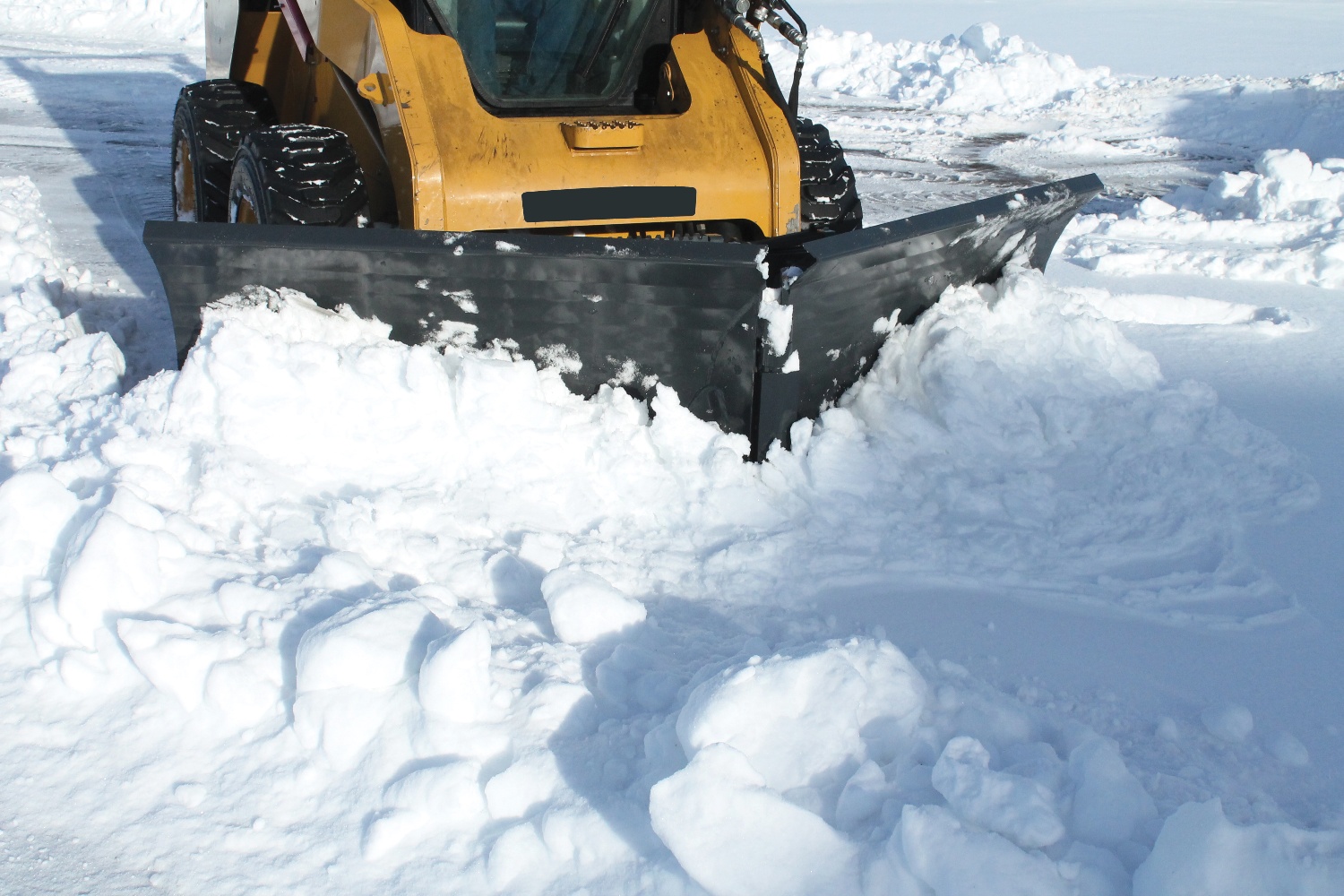
Pros
- Speed—Can travel as fast as the machine does, which allows for quick and effective snow removal.
- Stacking Ability—Since the blade sticks out further than a pusher or bucket, it allows snow to be stacked better and higher. It’s a night and day difference.
- Versatility—There’s a position for almost every situation. A V-Blade can imitate an Angle Blade, but an Angle Blade can never imitate a V-Blade. The Scoop and V positions can be huge time savers.
- Minimal Interruptions—Rigid moldboard and trip edge help minimize plowing interruptions.
- Side-to-Side Oscillation—Allows the cutting edge to follow the contour of the surface. Results in a cleaner plowed area and the ability to work over uneven terrain.
- No Electric—Blade angles hydraulically.
Cons
- Traction—May lose traction in deep snow.
- Containment—Unless wings are added, they don’t contain much snow.
- Complexity—More moving parts than snow pushers and buckets. Chance of hydraulic failure.
- Ground Sensitive—Most effective on hard surfaces like pavement or concrete.
- Won’t work well on gravel unless the ground is frozen or hardpack is present.
Choose a V-Snow Blade Attachment When:
- You’re in a wide-open space where you can plow in both directions, such as a commercial parking lot.
- Containment is less important.
- You need to stack snow as high as possible.
- You want a better view of the corners of your attachment.
Matching a V-Snow Blade to Your Skid Loader
What Width Should I Purchase?
At minimum, the V-Snow Blade width at full scoop position should be wider than your machine’s tracks or tires. The attachment should have a recommended loader capacity rating that matches or is lower than the loader operating capacity. Always refer to the attachment’s spec table to see which model works for a machine.
A small-to-mid-sized skid steer will effectively handle an 84” or 96” V-Blade. A large-framed skid steer will effectively handle a 108” and 120” V-Blade. Selecting a V-Blade that is too wide will add weight, volume, and surface area, all factors that could affect performance.
In heavier snow, a loader is more likely to break traction and quit plowing. If plowing long runs or wet and heavy snow, then an 84” or 96” will likely be the better choice—regardless of machine size.
Hydraulic Snow Blade Pusher Skid Steer Attachments
A hydraulic snow blade pusher (HSBP) is like a snow blade and snow pusher built into the same attachment. From inside the cab, operators can quickly transform the attachment from a straight blade to a snow pusher or any position in between.
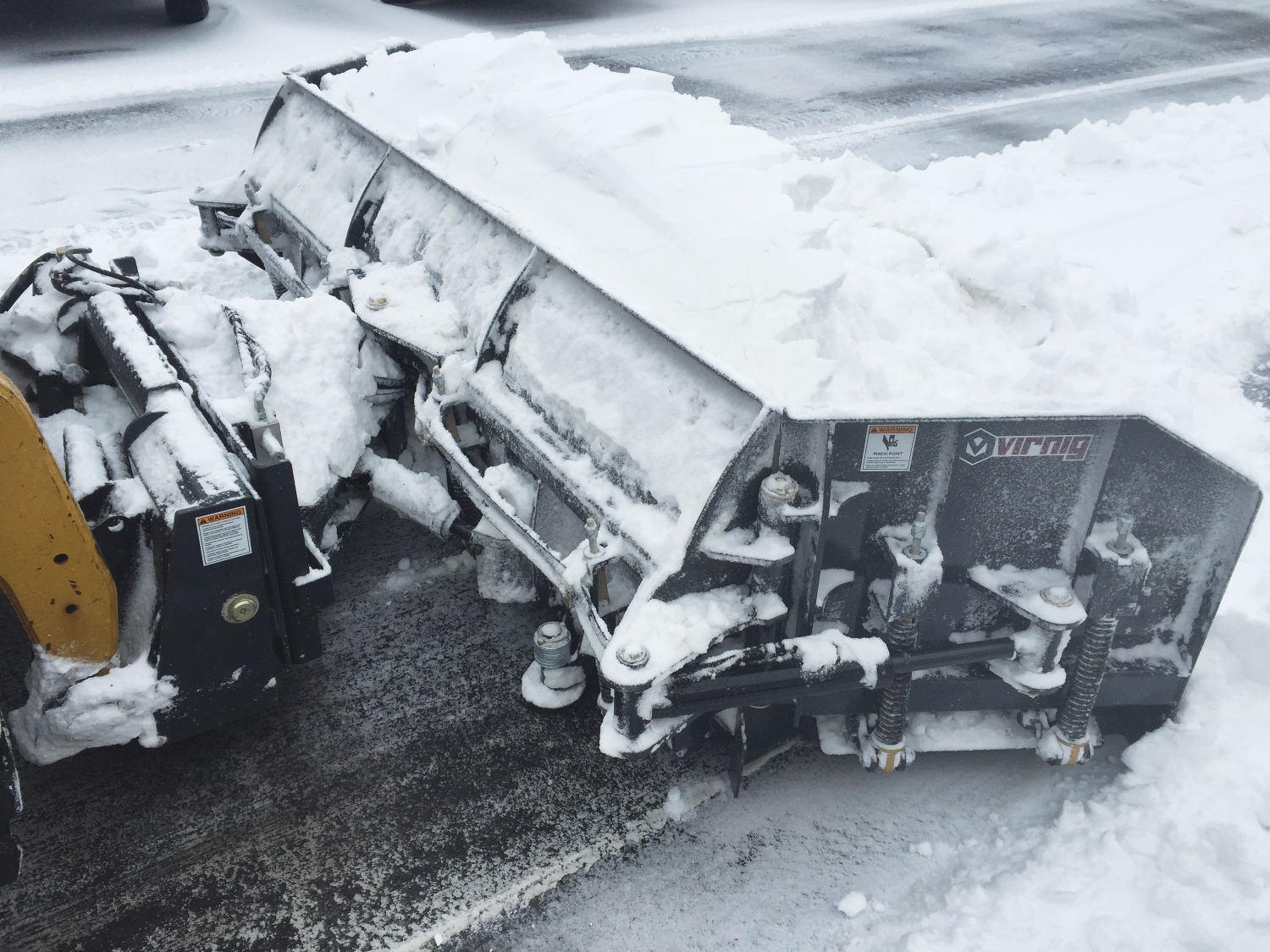
Pros
- Maximum Control—Independent angling of each wing, and the entire blade angles separately from the wings. Variable pusher, straight, and angle positions allow the operator to efficiently windrow, push, scoop, pile, and back drag snow all with one attachment.
- Minimal Interruptions—Rigid moldboard and trip edges help minimize plowing interruptions.
- Side-to-Side Oscillation—Allows the cutting edge to follow the contour of the surface. Results in a cleaner plowed area and the ability to work over uneven terrain.
- Floating Frame Link—Blade/Pusher maintains full blade contact when wings are angled, while allowing down pressure when the wings are straight.
- Fewer Windrows—Contains the snow until it overfills.
- Back Drag—Ability to pull snow away from buildings or objects.
Cons
- Expensive—More up-front cost than snow buckets and snow blades.
- Traction—May lose traction in deep snow.
- Complexity—More moving parts than snow pushers and buckets. Chance of hydraulic or electrical failure.
- Ground Sensitive—Most effective on hard surfaces like pavement or concrete.
- Won’t work well on gravel unless the ground is frozen or hardpack is present.
Choose the Hydraulic Snow Blade Pusher When:
- You need to stack snow as high as possible.
- You want maximum versatility.
- You’re mainly clearing large areas like parking lots or driveways.
Matching an Hydraulic snow blade pusher to Your Skid Loader
What Width Should I Purchase?
There are a number of factors to consider when purchasing an HSBP. Consider the loader’s operating capacity. For all Hydraulic Snow Blade/Pusher models, Virnig recommends at least 1800 lbs in operating capacity.
The overall size of your loader and type of tire or track. Some smaller loaders may have the lift capacity to use an HSBP, but can’t push the weight of a fully-loaded HSBP144 or HSBP156. Some don’t have snow tracks or tires and cannot get proper traction. In both of these cases, an HSBP120 or HSBP132 is recommended.
Trailer size. The HSBP156 is 11’ wide at full scoop and not every trailer is designed to handle a blade that wide. See the spec table for dimensions on each model.
The size of the area to be plowed. If mainly plowing parking lots, a wider attachment like the HSBP156 with more volume will increase your efficiency (provided the above factors are met). If the area to plow is a driveway, then a narrower model such as the HSBP120 or HSBP132 may be a better fit.
How to Choose the Right Snow Removal Cutting Edge
There are three primary cutting edges to consider when choosing a skid steer snow removal attachment. Below you will find details about each of these edge options:
- Steel Cutting Edges
- Poly Cutting Edges
- Rubber Cutting Edges
Steel Cutting Edges
Steel cutting edges offer the best scraping ability.
Steel is the most commonly used cutting edge in the U.S. and for good reason. It performs best with hard-pack snow and ice. The rigidity of steel gives the operator the ability to scrape away ice and hard-pack snow.
If you encounter these types of plowing conditions and prefer the plowed surface to be clean, then steel is a wise choice. Keep in mind that the use of steel edges has the potential to wear down the sealant on driveways or leave surface marks.
Poly Cutting Edges
Poly cutting edges offer a popular alternative to steel edges.
Poly has a better bite than rubber. It is a great option when you do not want to leave any marks on the surface being plowed. It may not scrape as well as steel, but it will be better than rubber on hard-pack.
Remember that not all poly cutting edges are created equal. Some of the toughest poly edges are made from reprocessed UHMW (Ultra High Molecular Weight) Polyethylene.
Depending on the situation, you could choose to have a steel, poly, and rubber cutting edge available. With a little effort, the edge can be changed or reversed.
Rubber Cutting Edges
Rubber cutting edges are great for preventing surface damage.
It’s quiet. If you have early morning routes, your customers will appreciate the rubber cutting edge. A rubber edge also decreases vibration.
Performs best with fresh snow or slush. The flexibility of rubber material allows it to mold to the surface. It creates a squeegee effect and maximizes performance.
A rubber cutting edge will cost extra, but it should widen your customer base.
Safely Maintaining and Operating Snow Removal Skid Steer Attachments
These general tips for pushing snow should help you have a safe and successful snow season. Be careful out there.Maintenance Tips for Skid Steer Snow Movers
Whether you buy a new or used snow attachment, it’s always important to keep up with regularly scheduled maintenance and replace worn or defective parts as soon as they’re detected.
Also, keep a close eye on wear parts like the cutting edges and skid shoes. Each attachment will have areas that must be greased, and the Snow Blower motor oil needs to be checked regularly and filled with the proper oil. Use the manual for maintenance information and stick to a schedule. You can count on years of reliable performance if it’s well maintained.
General Operation Tips for Skid Steer Snow Movers
- Always follow safety information and read the manual for your attachments prior to use.
- Always follow all safety and operating instructions of your skid loader.
- Never ram piles. Damage to the attachment and/or skid loader may occur.
- Care should be taken to avoid hidden obstructions (curb, posts, etc.)—damage to the attachment and/or skid loader may occur.
- Never use Virnig blades to push any material other than snow.
- Check for debris in the quick-tach area before each hook-up.
- For blades and blowers, always relieve pressure before disconnecting hydraulic hoses. Also, never hit or pound couplers.
Virnig's Naming Series
For attachments with comparable counterparts, there are a variety of factors to determine the series. This includes steel thickness, amount of bracing, capacity, or simply the number of options to specialize the attachment.
 |
Mini skid steer attachments designed for peak performance and crafted to be the toughest in the market. Small but powerful, they embody Virnig quality. |
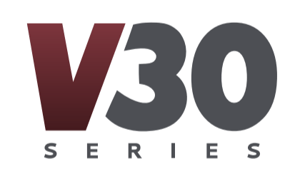 |
Ideal for compact tractors and small skid steers with less than a 1,500 lb operating capacity. |
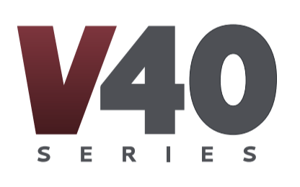 |
Lighter-duty with minimal options for small to medium frame skid steers. Works well for homeowners and DIYers. |
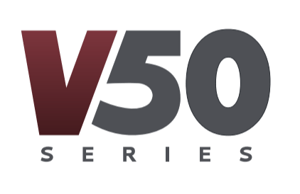 |
For medium to large frame skid steers. Though this is Virnig’s standard-duty line, the V50 Series often outperforms other brands’ heaviest skid steer attachments. |
 |
High-Performance attachments constructed for large frame skid steers. Ideal for commercial operations, they are designed to withstand years of tough jobs. |
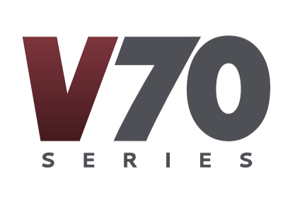 |
Virnig’s new attachment class with the best durability and performance; solely contains the Tree Disc Mulcher. As skid steers increase in size and jobs become more demanding, Virnig will continue to add to the V70 line-up. |
Virnig Snow Removal Attachments
When it comes to choosing the best snow removal equipment, it pays to look at quality first. That’s both the quality of materials and the quality of design.
At Virnig Manufacturing, every attachment is designed and manufactured in-house at our facility in Rice, Minnesota. With 16 different snow removal attachments—and 50 models to choose from—the Virnig lineup is a great place to begin your research. Click through to any of the attachments below to see their specifications, design, and durability.
- V20 Snow/Light Material Bucket
- V40 Snow/Light Material Bucket
- V50 Snow/Light Material Bucket
- V60 Snow/Light Material Bucket
- V30 Compact Tractor Angle Snow Blade
- V40 Angle Snow Blade
- V50 Angle Snow Blade
- V60 Angle Snow Blade
- V60 V-Snow Blade
- V50 Low Profile Snow Pusher
- V60 Snow Pusher
- V60 Steel Edge Snow Pusher
- V60 Hydraulic Snow Blade/Pusher
- V50 Snow Blower
- V60 Snow Blower
- Angle Broom
Our skid steer attachments’ major components are manufactured with the latest technologies to yield a product that continually outperforms the competition. The product line is backed by a 1-year warranty and an on-going customer support system. Plus, Virnig carries over 40,000 attachment parts that are in stock and ready to ship the same day an order is received.
Contact Virnig or your local Virnig dealer and they will help you get the proper type of attachment for your applications, machine size, and budget.



